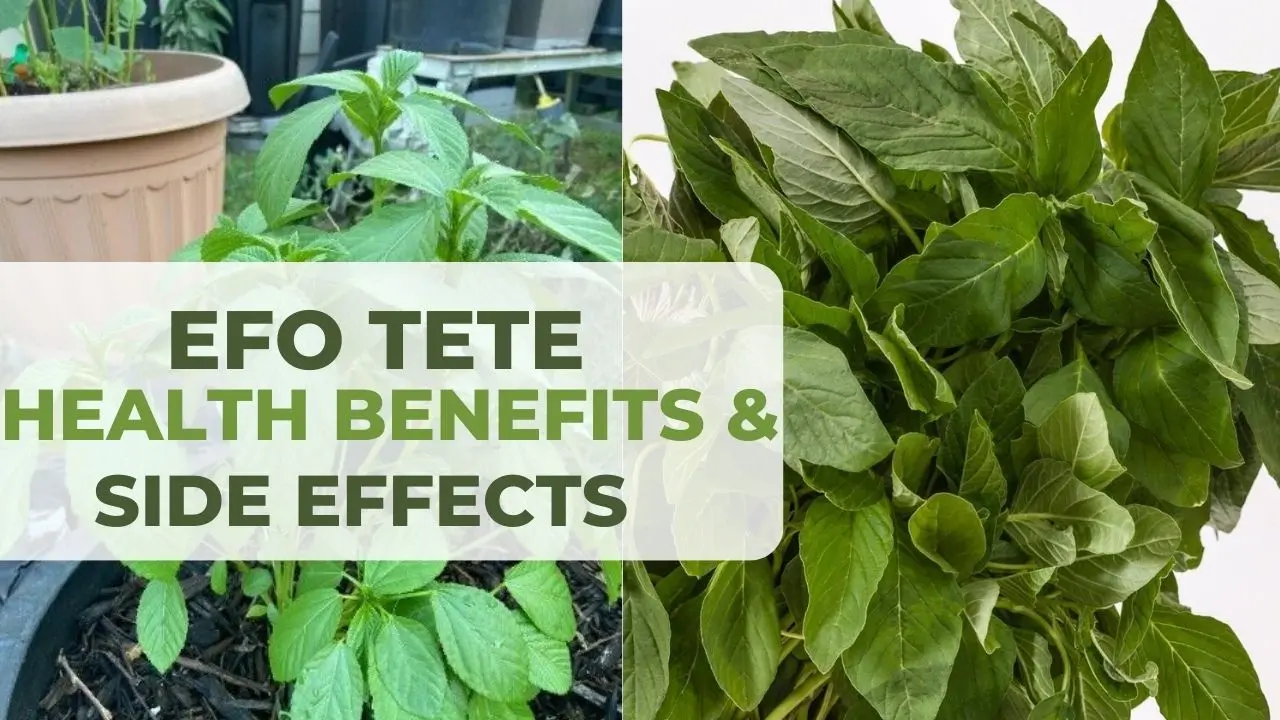Vegetable leaves are an important part of Nigerian foods, especially soups and stews. They are used in almost all soups as an accompaniment to carbohydrates and served as a side dish. One of Nigeria’s most popular and widely consumed leafy vegetables is Efo Tete, also known as Nigerian amaranth leaf or green leaf.
The leaf is used to make the famous Yoruba soup, Efo oriro, which is a very nutritious soup that is combined with Efo Shoko (Lagos spinach) to create a mouth-watering dish that is loved not just in Yorubaland but all over Nigeria. But then, what is this leaf, where does it come from, and what are its benefits and side effects?
In this article, we will explore everything you need to know about Efo Tete (Nigerian Amaranth Leaf) and answer some frequently asked questions, so you’ll have all the knowledge you need to incorporate this leaf into your soups, stews, or diet. Let’s begin!
What is Efo Tete?
Efo Tete is the Yoruba name for amaranth greens, a leafy vegetable belonging to the Amaranthaceae family. There are many amaranth plants, but the one commonly grown and eaten in Nigeria is Amaranthus hybridus L.
It is also called Inine in Igbo, Alefu in Ghana, Callaloo in Jamaica, Bayam in Malaysia, and Spinach in English. However, it is not related to spinach botanically, although it has a similar but more robust flavour than spinach.
The leaf has green or reddish leaves that are tender and slightly bitter. The leaves are usually harvested when young and fresh before flowering. The leaves can be eaten raw in salads or cooked in soups and stews. The leaf is combined with Efo shoko to make Efo oriro, one of Yoruba’s famous foods.
History and Origin of Efo Tete
Efo tete, known scientifically as Amaranthus viridis, has a long global history of cultivation and consumption spanning thousands of years. Indigenous civilizations in the Americas, like the Aztecs, Incas, and Mayans, domesticated amaranth as a staple crop and used it in religious ceremonies. However, Spanish colonisers banned amaranth in the 16th century due to its ritual symbolism.
Amaranth endured as a wild edible despite suppression by the Spanish and was reintroduced through trade and migration. In Africa, amaranth was brought by enslaved people from the Caribbean to West Africa in the 17th and 18th centuries. It flourished in the tropical climate and became famous as an affordable green vegetable called efo tete in Nigeria.
Today, Amaranth leaf remains essential to millions’ cuisines, livelihoods, and health. It adapts readily to diverse environments, from Asia to Africa and South America. Efo tete is widely grown and consumed in Nigeria and across West Africa. Its resilience, nutrition, and affordability cement its enduring importance in African agriculture and food culture.
Nutritional Facts About Nigerian Amaranth Leaf (Efo Tete)
Nigerian amaranth leaf is a highly nutritious vegetable that provides a variety of vitamins, minerals, antioxidants, and phytochemicals. According to the USDA National Nutrient Database, 100 grammes of raw amaranth leaves contain the following nutrients:
- Calories: 23 kcal
- Protein: 2.46 g
- Carbohydrate: 4.02 g
- Fibre: 2.1 g
- Fat: 0.33 g
- Vitamin A: 2917 IU
- Vitamin C: 43.3 mg
- Vitamin K: 1140 mcg
- Folate: 85 mcg
- Calcium: 215 mg
- Iron: 2.32 mg
- Magnesium: 55 mg
- Potassium: 508 mg
- Zinc: 0.9 mg
As you can see, this leaf is a rich source of vitamin A, vitamin C, vitamin K, folate, calcium, iron, magnesium, potassium, and zinc. These nutrients are essential for maintaining good vision, the immune system, blood clotting, DNA synthesis, bone health, blood formation, muscle function, nerve function, and wound healing.
The leaf also contains other beneficial compounds such as beta-carotene, lutein, zeaxanthin, squalene, rutin, and gallic acid. And anti-microbial properties. These compounds have antioxidant, anti-inflammatory, anti-cancer, anti-diabetic, and anti-ulcer properties.
Health Benefits of Amaranth Leaf
Eating Efo leaf regularly can provide many health benefits for your body and mind. Here are some of the most notable benefits of the leaf:
Weight Loss
Using the leaf in your diet can help with weight loss. The leaf is low in calories but high in fibre and protein, which enables you to feel full longer and prevents overeating. It also contains compounds that modulate your appetite hormones and inhibit fat absorption.
Blood Sugar Control
Consuming the leaf can help control blood sugar levels and prevent or manage diabetes. It is low in glycemic index (GI) and glycemic load (GL), which means it does not cause a rapid spike in blood glucose after eating. It also contains compounds that can improve insulin sensitivity and glucose uptake by cells and protect the pancreas from oxidative stress and inflammation.
Blood Pressure Regulation
Adding the leaf to your diet can also help lower blood pressure and prevent or treat hypertension, thanks to its high potassium and magnesium content. The leaf contains compounds that can inhibit the activity of angiotensin-converting enzyme (ACE), which constricts blood vessels and increases blood pressure.
Digestive Health
Using the leaf in your diet can help relieve constipation and improve bowel movement by adding bulk to stool and stimulating intestinal muscles to contract. The leaf also contains compounds that can increase bile secretion and digestive enzymes that help break down food and facilitate its passage through the gut.
Cardiovascular Health
The leaf can help lower cholesterol levels and improve cardiovascular health due to its high phytosterol content, which can compete with cholesterol for absorption in the intestines. The leaf also contains compounds inhibiting cholesterol synthesis in the liver and enhancing cell cholesterol uptake. It also contains antioxidants and anti-inflammatory compounds that protect blood vessels from oxidative damage and inflammation that can lead to atherosclerosis and heart disease.
Ulcer Prevention and Treatment
The leaf can help heal and prevent ulcers in the stomach and intestines by coating and protecting the lining of the digestive tract from the corrosive effects of gastric acid and bacteria. It also contains compounds that can inhibit the growth of Helicobacter pylori, a common cause of peptic ulcers.
Sexual & Reproductive Health
Using the leaf in your diet can help boost libido and sexual performance, as it is high in zinc, an essential mineral for the production and function of testosterone. The leaf also contains compounds that can increase blood flow to the genitals and enhance arousal and sensation.
Consuming the leaf can help improve fertility and reproductive health due to its high folate content, a vital nutrient for DNA synthesis and embryonic development. Folate can prevent congenital disabilities such as neural tube defects, which affect the brain and spinal cord of the baby. The leaf also contains compounds that can balance hormones and regulate the menstrual cycle, ovulation, implantation, and pregnancy.
Side Effects of Efo Tete (Amaranth Leaf)
Efo tete is generally safe and beneficial for most people, but it may also have some side effects or interactions with certain medications or conditions. Some of the possible side effects are:
- Allergy: Some people may be allergic to leafy green vegetables or other members of the amaranth family. Symptoms of an allergic reaction may include itching, rash, swelling, difficulty breathing, or anaphylaxis. If you experience these symptoms after consuming leafy green vegetables, stop drinking them immediately and seek medical attention.
- Anticoagulants: Leafy green vegetables are high in vitamin K, which is involved in blood clotting. If you take anticoagulant drugs such as warfarin or heparin, you may need to monitor your blood clotting time and adjust your dosage accordingly. Eating too much or too little of these vegetables may interfere with the effectiveness of your medication and increase your risk of bleeding or clotting.
- Kidney Stones: Leafy green vegetables are high in oxalates, compounds that can bind with calcium and form crystals in your urine. These crystals can accumulate and form kidney stones, which can cause pain, infection, or obstruction in your urinary tract. If you have a history of kidney stones or a high risk of developing them, you may need to limit your intake of these vegetables and other oxalate-rich foods such as spinach, rhubarb, beetroot, chocolate, tea, and nuts.
- Gout: Leafy green vegetables are high in purines, compounds that can be broken down into uric acid in your body. Uric acid can accumulate in your joints and cause inflammation and pain, known as gout. If you have gout or a high uric acid level in your blood, you may need to avoid or reduce your consumption of these vegetables and other purine-rich foods such as meat, seafood, beer, wine, and cheese.
Efo Tete in Igbo
Amaranth is a leafy vegetable widely consumed in Nigeria, especially among the Yoruba people. It is also known as amaranth greens, African spinach, or simply green in English. But what is the name of this vegetable in Igbo? In Igbo, the leaf is called inine.
Benefits and Risks for Pregnant Women
While pregnant women can benefit from the nutrients in this vegetable, such as folate, iron, calcium, and vitamins A, C, E, and K, they should consume it in moderation. Efo tete contains oxalates and purines, which can increase the risk of kidney stones or gout flares in susceptible women.
Additionally, it has high levels of vitamin K, which can interfere with anticoagulant medications. Pregnant women with kidney issues, gout, or using blood thinners should avoid excessive consumption and consult a doctor first.
In conclusion, efo tete can nurture pregnant women and babies when eaten mindfully and appropriately.
Botanical Information
Amaranth leaf is a type of leafy vegetable that belongs to the genus Amaranthus in the family Amaranthaceae. This family is part of the order Caryophyllales in the class Magnoliopsida (dicotyledons) in the division Magnoliophyta (flowering plants) in the kingdom Plantae.
Amaranthus comprises about 60 to 70 species of annual or short-lived perennial plants distributed nearly worldwide.
Some common names for amaranth leaf include amaranth greens, African spinach, green, inine, alefu, callaloo, bayam, vlita, and pigweed. The botanical name for amaranth leaf varies depending on the species, with Amaranthus hybridus L. being the most commonly consumed variant.
Frequently Asked Questions
What Is Efo Tete Called in English?
Efo Tete is called amaranth greens or amaranth leaves in English. It is also known as spinach but is not related to spinach botanically.
How Does Amaranth or Efo Tete Look Like?
Amaranth, or Efo Tete, is a vegetable with green or reddish leaves that are tender and slightly bitter. The leaves are usually harvested when they are young and fresh before they flower. The seeds of the amaranth plant are also edible and nutritious.
What Is the Scientific Name for Efo Tete?
The scientific name for Efo Tete is Amaranthus hybridus L. It belongs to the Amaranthaceae family, which includes other plants such as quinoa, chard, beetroot, and celosia.
What Is the Common Name for Amaranthus in Nigeria?
The common name for Amaranthus in Nigeria is Efo Tete in Yoruba, Inine in Igbo, Alefu in Ghana, Callaloo in Jamaica, Bayam in Malaysia, and Spinach in English.
What Can I Substitute for Amaranth Leaves or Efo Tete?
If you cannot find amaranth leaves or Efo Tete, you can substitute it with other leafy vegetables with similar texture and flavour, such as spinach, kale, collard greens, Swiss chard, or watercress. However, the nutritional value and health benefits may vary depending on the type of vegetable you use.
Conclusion
Efo tete is a leafy vegetable that is delicious and highly nutritious, benefiting your body and mind. It has been known to aid in weight loss, diabetes, hypertension, constipation, cholesterol, ulcers, libido, and fertility. However, it is essential to note that Efo Tete may also have side effects or precautions you should be aware of, such as allergies, anticoagulants, kidney stones, and gout. Therefore, it is recommended to consume Efo Tete in moderation and consult your doctor if you have any medical conditions or medications that may interact with it.
Efo tete is a versatile vegetable prepared in various ways and dishes. It can be enjoyed as a main course or a side dish, alone or with other ingredients. Experimenting with different spices and vegetables can enhance their flavour and aroma. Including Efo Tete in your diet can provide you with many health benefits that your body requires.




